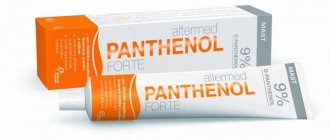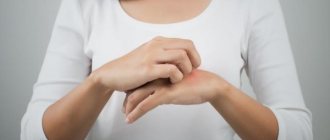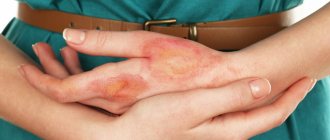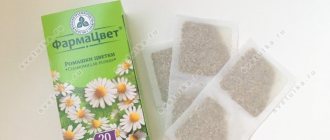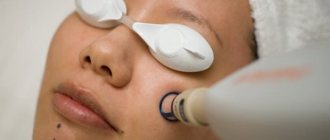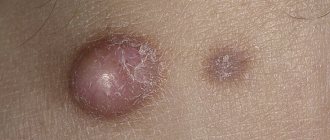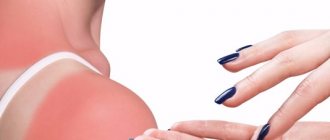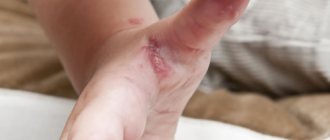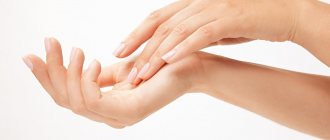What to do if you burn your finger: first aid and further treatment
A finger burn is an injury caused by deep or superficial damage to the limb from a hot object or chemical substance. It is important to provide first aid to the victim and quickly relieve pain from a burn on the finger.
First aid for a finger burn
After receiving an injury, you need to immediately help the victim. Such skin lesions are dangerous and can affect the functionality of the limb.
Thermal
Such a defect can be obtained on a finger during daily housework. It is caused by contact of the dermis with hot objects:
- teapot;
- soldering iron;
- stove;
- ferry;
- iron;
- light bulb;
- curling iron
When preparing food, it is easy to get injured by exposing an area of skin to hot soup or tea; If you accidentally touch a hot pot, frying pan or boiling oil, you can get seriously burned. Fire and boiling water, getting on the delicate skin film, provoke injury to the upper layers.
The extent of damage will depend on the following factors:
- Time of contact with skin.
- Temperatures.
- Type of object or liquid.
- Area of damaged surface.
The depth of the finger injury is determined during the examination.
If the injury occurred in the interdigital space, the degree is more severe. The skin in these areas is thinner than on the pads and phalanges.
In the first degree of injury, healing occurs after five days without the use of medications.
Do not use badger fat, butter or sunflower oil for lotions.
For small lesions of the skin, cooling will help, for large lesions, painkillers will be required:
- eliminate the source of exposure to the skin;
- cool the damaged area under running water for 12-17 minutes;
- To dry, gently blot with a napkin;
- Use a weak solution of manganese or medical alcohol as disinfection.
What to do if a burn blister appears on your finger:
- cool with water;
- apply a bandage;
- Do not open the bubble.
The resulting liquid inside the blister will resolve within 3-5 days, and the skin will dry out.
If a large area of skin is damaged in grades 3 and 4, you need to cover it with gauze and consult a doctor.
| Degree | Symptoms |
| 1 | Pain, redness of the dermis. |
| 2 | The appearance of vesicles. |
| 3 | Formation of an open lesion. |
| 4 | Carbonization of tissues, the occurrence of dry necrosis, loss of sensitivity. |
Electric
Such injuries require hospitalization. Electrical injuries are not common, but they are more dangerous.
Injury occurs in the hands and heels, which form an electric arc. Tissue and tendon rupture occurs (even fractures).
When providing first aid, the patient goes through a number of stages:
- Eliminate contact of the victim with an electrical source, use products that are not electrically conductive.
- Cover the burn surface with a sterile bandage.
- Call an ambulance.
- Arrange for hospitalization.
It is forbidden to eliminate the impact of an electrical source on a person with unprotected hands.
Chemical
This type of injury is represented by defects in the dermis due to exposure to aggressive acids and alkalis. If handled carelessly, the glue can cause damage to the skin film. This may include chemicals, sink, toilet, bathtub cleaners, or vinegar.
When exposed to chemicals, tissue necrosis of coagulation or colliquation types occurs.
A symptom of exposure to acids is a dense scab, and a symptom of alkali is non-healing wet areas.
First aid for a chemical burn consists of the following steps:
- remove the product from the dermis;
- carefully remove clothing from the area;
- rinse the wound thoroughly under the tap;
- provide adequate pain relief with medications;
- cover the affected surface with a sterile bandage;
- arrange hospitalization.
Ointments and Panthenol should not be used to neutralize chemicals. This leads to a negative reaction in combination with product residues.
In this case, water will be enough, which will help wash away the remaining chemicals from the thin layers of the epidermis.
In cases of contact with chemicals on the skin, immediately seek help from specialists to avoid ulcerative formations on the dermis, which may swell.
Treatment methods at home
1st and 2nd degree burns can be treated at home; other injuries require medical intervention. Be careful and do not use untested recipes to avoid infection.
Pharmacy ointments
If a finger is burned at home after cooling with water, it is recommended to use ointments that can be purchased at a pharmacy on the recommendation of a doctor:
- Bepanten;
- Dermazin;
- Dimexide;
- Solcoseryl on a gel basis;
- Sulfargin;
- Argosulfan;
- Levomekol.
Such products allow deep wounds to heal in a short period of time (thanks to accelerated skin regeneration).
Positive features of ointments:
- practically do not cause side effects;
- quickly absorbed into the blood (compared to tablets and injections);
- convenient for home use;
- several components are present simultaneously.
Comparative characteristics of popular ointments
| Name | Advantages and disadvantages |
| Levomekol |
Effective for thermal injuries of degrees 1 and 2. Apply 2 times a day for 5-7 days. |
| Panthenol |
Available in sprays, emulsions, ointments. Analogues: Bepanten, Dexpanthenol. Anoint the burned area 1-2 times a day. |
| Argosulfano |
Disadvantage – causes allergies. Advantage – duration of use is up to 2 months. Spread on the affected area 2-3 times a day. |
According to reviews, if the little finger has suffered from burning, Rescue Forte balm (contains Panthenol) often helps. During the first minutes of use, a burning sensation appears, but the drug allows you to quickly relieve pain (thanks to the vegetable oils contained in the ointment).
Tyrosur gel is also effective. Quickly eliminates infection and heals wounds on hands in a week.
Reskinol has helped many patients get rid of minor injuries in a few seconds when starting a fire. Effectively heals wounds without leaving scars.
ethnoscience
In parallel with the cooling, which is carried out in the first minutes after a skin injury, you can use this effective folk method: put a compress of potatoes or potato starch on the affected area. You can replace the ingredient with an infusion of flax seed or oatmeal.
Oil solutions should not be used in the first 24 hours after injury. The formation of thermal protection occurs, which prevents heat exchange with the affected area. The temperature in the area increases, this can lead to greater coverage of the lesion.
Consider medicinal folk recipes:
Recipe No. 1
- 5 drops of aloe juice;
- soak napkins;
- apply to the affected area.
Antibacterial, fast healing.
Recipe No. 2
- 100 g St. John's wort;
- 60 ml vegetable oil;
- boil for 30 minutes;
- cool for 30 minutes.
Antibacterial, drying, healing effect.
Recipe No. 3
- 100 g blueberries;
- cook for 10 minutes;
- drain the water;
- cool 30 minutes;
- rub and apply to the burned area.
Analgesic, anti-inflammatory effect, reduces severe spasms.
If your index finger is damaged by a fire, a plantain leaf will help. It must be washed and applied to the affected area.
What to do if a blister forms
A burn on a finger that has resulted in a blister should not be opened. This may lead to infection.
If a child burns his finger, it is necessary to urgently remove the injured object and apply an ointment based on a beekeeping product, mixed with sea buckthorn oil.
Decoctions of oak bark, chamomile, and string are effective. Bepanten and Panthenol will help relieve pain: after using them, the bubble may burst without a puncture, and the finger will stop hurting.
For prevention purposes, it is necessary to remove hazardous substances and objects from the child’s field of vision.
For adults, you can use ointments, sprays and folk recipes.
But if the burned area is 10% of the skin, the victim must be hospitalized.
Follow the tips in the article to get rid of the pain of a burned surface. They will indicate what to do if a finger is burned in emergency situations, what treatment to take so that wound healing is quick and painless.
The article has been verified by the editors
Source: https://BezTravmy.ru/ozhogi/paltsa.html
What to do if you burn your finger at home
At the burn site, the victim experiences pain of varying intensity.
A finger burn refers to an injury that occurs at home, at work or in everyday life.
Damage to the skin can be superficial, or deeper layers are affected. At the burn site, the victim experiences pain of varying intensity. It is not always possible to eliminate injuries sustained at home on your own.
Deep lesions require qualified treatment.
Finger burns are classified by degree
- the superficial lesion is accompanied by redness, stinging pain and slight swelling.
- Painful blisters or blisters containing lymph appear on the skin.
- a painful necrotic process of tissue begins with the formation of a scab.
- complete death of soft tissues affecting bone and muscle tissue.
What to do if your finger is burned?
There is an important algorithm for providing assistance. First of all, eliminate the impact of the object that caused the burn. Then his character is determined. In only two cases of tissue damage, washing cannot be used - in case of burns with quicklime and sulfuric acid. These substances are first removed from the finger with a cloth, gauze or bandage.
Rinse your finger under cold running water.
What to do with the rest of the burns on the finger? The third point is to rinse the skin under cold running water.
If there was exposure to acids, then clean water is replaced with a soap solution. To neutralize the effect of alkalis, it is necessary to rinse your fingers with a liquid with the addition of a few drops of lemon juice.
Treatment with local drugs is not included in first aid for a finger burn if the injury exceeds the first degree. When using a manganese solution, make sure that it is not intensely colored. It is enough to dilute the crystals to a faint pink hue.
The bandage is used to make a loose bandage.
At the final stage, it is necessary to prevent the entry of the infectious agent. A bandage is made from a sterile bandage; it should not be too tight. The fingertips are covered with a special anti-callus plaster and secured with a fingertip.
Treatment at home
If you burn your fingers with boiling water, it is recommended to immediately immerse them in cold water. This will stop the negative thermal effects.
Drug therapy
Panthenol normalizes cell turgor and restores their structure.
Special ointments will help speed up healing. But they can be applied no earlier than two hours after the injury.
Most drugs contain panthenol, which normalizes cell turgor and restores their structure. For more severe burns, use Levomekol. It is also permissible to use pain-relieving ointments, for example, Ketonal.
But if blisters appear, it is better to use oral analgesics.
What to do if a blister forms?
Treatment of skin with such an injury includes rinsing and applying a loose bandage to prevent microbial contamination. When blisters appear, during the first two days the burn is purulent-necrotic in nature.
The fluid inside the blisters becomes cloudy, and the surrounding tissue becomes inflamed. Every 4 hours, the bandage is changed and moistened with antiseptic solutions so that it does not dry out to the skin.
Opening the fluid capsule may result in a lengthy healing process.
Large blisters are best treated in a hospital setting. A visit to the doctor will be mandatory if they fester and cause severe pain. Another symptom of infection will be an increase in body temperature. Opening the bladder must be carried out under sterile conditions.
Source: https://stoptravma.ru/ozhog/paltsa
Severity
The severity of symptoms and first aid measures depend on the severity and area of the burn. This can be assessed by the appearance of the affected skin. In any case, you need to be able to react quickly to reduce the likelihood of consequences.
Degrees and their features:
- The first is that only the superficial layer is affected. Pain, redness, and tissue swelling appear. In most cases, complete recovery occurs within 7 days without any traces.
- The second is with the formation of blisters. With the right treatment tactics, recovery occurs in up to 2 weeks without consequences.
- The third is with necrosis, that is, tissue death. The formation of a crust or scab can be observed over the wound. Healing is very slow and marks remain.
- The fourth - with charring of the skin. The most severe degree of burn with damage to the muscle layer and bones. The condition requires urgent hospitalization.
Thermal burns in the hand area are quite common. This is due to ignorance or ignorance of safety precautions and carelessness. Everyone should know what to do if a finger is burned at home so that healing occurs quickly and without complications.
Finger burn: what to do at home?
Finger burns are a painful injury that often occurs at home. The damaged skin burns and is very painful. Patients who have suffered burns to their hands require emergency first aid and proper treatment.
People who know what to do if a finger is burned quickly cope with the problem. In case of mild thermal or chemical injuries, they get rid of the burn with the help of pharmaceutical and folk remedies.
For severe burns, seek help from a doctor.
Drug treatment
The burn is treated with medications after cooling. For this use:
- Pharmacy gel dressings. They suppress pain and speed up healing.
- Anti-burn medications: sea buckthorn oil, Panthenol spray, Bepanten Plus cream, Olazol, Radevit ointment.
It doesn’t matter what you burn your finger with: boiling water, hot milk, steam, open fire or oil, in case of damage, no matter what they caused, first aid and treatment are carried out according to the same scheme.
Security measures
If your finger is burned, do not do the following:
- Cool the wound with ice. Direct contact with it may result in tissue frostbite.
- Treat the burn with alcohol-based antiseptics (brilliant, iodine) and toothpaste.
- Lubricate open damage with greasy or oily products.
- Apply a tight bandage.
- Protect the wound with adhesive tape.
It is necessary to carefully handle skin with blisters. Maintaining the integrity of the blisters is a prerequisite for safety. They prevent pathogens from entering the wound.
Traditional treatment methods
Folk remedies help cure finger burns.
Herbal extracts are not effective if blisters form on the burned area. The blister will not allow them to penetrate deep into the tissue.
To relieve signs of a burn and prevent wound infection, use:
- Woodlice juice. The juice is squeezed out of the grass and applied to the affected skin. Home remedy relieves pain and speeds up healing.
- Boiled onions alleviate the condition and speed up recovery. The onion along with the husk is placed in a saucepan, filled with water, and cooked until tender. Remove the head from the broth, cool, and peel. The pulp is turned into pulp. Tied to the sore spot.
- Calendula oil helps treat burned skin . It has bactericidal and anti-inflammatory effects. The wound heals quickly, the product prevents the formation of scars. A napkin soaked in oil is wrapped around the finger and secured with a bandage. Do two dressings a day. The product should not be used for first aid for burns. It is used when the skin is cool.
- At home, burnt fingers are treated with veronica decoction. Place 20 g of herb in 250 ml of boiling water and filter after cooling. You can use it to make lotions and wash wounds.
- Compresses made from raw potatoes or pumpkin. To make the applique, vegetables are crushed into a paste. Place the product on a napkin and tie it to your finger. The dressing is changed as soon as the paste warms up.
- Burns are successfully treated with cabbage leaves. Take the white of a fresh chicken egg and add to it an equal amount of pulp obtained from a cabbage leaf. Apply to the burn.
- Cabbage leaves are boiled in milk and pureed. Mix with rye flour to form a flatbread. Fixed on the affected area.
- If your hand and fingers are burned, apply lotions with eucalyptus extract. Place 10 g of herb in 250 ml of water, bring to a boil, and simmer for 30 minutes. Filter, moisten a napkin, apply to the lesion. Change as it warms up (every 5-10 minutes) for an hour. Lotions cool burned skin and relieve discomfort. Do two procedures a day.
- Roses are used to treat 1st and 2nd degree burns. Freshly picked petals are applied to the wound and secured with a bandage. The application is removed when the petals are completely dry.
- Lotions with herbal extracts. A decoction is prepared from clover inflorescences, rose hips, and coltsfoot leaves. Brew a teaspoon of herbs in 200 ml of hot water. After 30 minutes, filter, soak a cloth with the product, and apply to the damaged skin. The application is changed as soon as the napkin warms up. The duration of the procedure is 1 hour. Lotions are made twice a day. Herbal extracts quickly heal burns, relieve pain, and prevent scars from forming.
- Sea buckthorn oil can even treat severe burns when tissue necrosis occurs. Apply the product to damaged skin and apply a bandage. The procedure is done twice a day.
- Light burns are treated with St. John's wort oil. Add a tablespoon of St. John's wort inflorescences to 250 ml of vegetable oil. Leave for 14 days to infuse. The bottle of medicine is shaken periodically. The oil is applied to the affected skin and a sterile bandage is applied. Bandages are changed twice a day.
- Calendula ointment helps combat finger burns. It is prepared like this: mix pharmacy tincture of calendula with petroleum jelly in a 2:1 ratio. The ointment is applied to damaged skin and bandaged. The dressing is changed twice a day.
Burns on the fingers should be treated after consultation with a doctor. Wounds need to be treated properly. With adequate treatment, damaged skin quickly recovers and there are no scars left on it.
Source: https://FitoOtvet.com/travmy-ozhogi/chto-predprinyat-pri-ozhoge-paltsa.html
Effective folk remedies
Among folk recipes, raw potatoes have proven to work well. Wash the vegetable, peel and finely grate. The resulting mass is applied to the wound and changes as it dries and heats up. Used for 1st degree.
You can also use cabbage leaves as a compress. Aloe leaves are no less useful. You can soak a gauze bandage in their juice and apply it to the wound.
The products are used only for stage 1 damage.
What you should not do at home if you have a finger burn :
- use oil solutions to treat the wound on the first day;
- apply ice.
- carry out treatment with iodine, brilliant green and other alcohol-containing products;
- pop bubbles;
- cover the burn wound with a plaster.
Burnt my finger how to relieve pain: burning blisters at home
Hello, dear readers and guests of the blog! Thermal burns are the most common household injury. You can get it in your own home. It is enough to make mistakes in handling household appliances. By fire. Boiling water. We shudder: “Oh! I burned my finger - how to relieve the pain? But you need to act quickly and correctly!
Classification of burns
Based on the depth of tissue damage, doctors distinguish four degrees of burns.
The first one is easy. The top layer of skin is damaged. The epithelium turns red and swells. The wound is accompanied by a strong burning sensation. Heals in 3-4 days even without treatment.
The second is of medium severity. The epithelium and dermis suffer. At the same time, blood vessels and nerve fibers remain in order. The person experiences acute pain and burning. Small blisters appear at the site of damage. They are filled with clear liquid. Heals within 2 weeks.
The third one is hard. The skin is damaged to its full depth. Blood vessels. Partially subcutaneous tissue. Large blisters form. Some of them burst. Pain sensitivity in the injured area decreases.
The fourth is extremely difficult. Skin, muscles, tendons, and bones are severely damaged. Necrosis of the injured area occurs.
The first two degrees cause burning and pain. The third and fourth are accompanied by pain only at the time of injury. Then pain sensitivity decreases. The reason is the destruction of nerve fibers.
I burned my finger - how to relieve the pain?
- The first thing is to eliminate the source of injury. Move the pan or hot item away. Turn off the electrical appliance.
- Then cool the affected area of skin. For some time it itself remains a source of heat. As a result, it damages healthy tissue. Don't skip this point! Otherwise, in an hour the burn will expand its borders.
- If you have anti-burn gel in your first aid kit, apply it to the affected finger. It will not only cool. Pain relief. Neutralizes the wound.
- When there are no special preparations, ordinary water can be used for cooling. She should have a temperature of 15-20 degrees.
- Remove the rings. Later, due to swelling, this will be difficult to do.
- After cooling, apply a sterile bandage to the burn site. In places where the blisters have burst, you can place pieces of clean cling film. It will not stick to the wound. This will make it easier for you to remove the bandage later. You don't have to tear it off with the meat.
- Need to numb the pain and burning sensation?
Take any analgesic. Apply a pain-relieving compress. It's easy to prepare. Soak the bandage in the novocaine solution. Apply to the sore spot.
What is prohibited to do!
- You should not use ice instead of water for cooling. Get frostbite.
- Do not apply oil to a fresh wound. It will slow down the healing process.
- Don't pop blisters! You risk introducing an infection.
- Do not cover the affected area with cotton wool. Its fibers will stick to the wound.
All of the above measures are first aid measures.
In many cases they are not enough. Treatment required!
When to see a doctor
- Always! If a child or elderly person is injured.
- Third or fourth degree burn.
- The respiratory tract, eyes, face, and groin area of the body were burned.
- If the burn area is more than five palms of the victim.
Pharmacy drugs
The pharmacy will offer a variety of products: ointments, aerosols, balms. A drug with several pharmacological properties should be selected. It should relieve swelling and pain. Accelerate tissue restoration. Levomekol ointment will do the job perfectly. Aerosol Olazol. Time-tested Panthenol spray.
